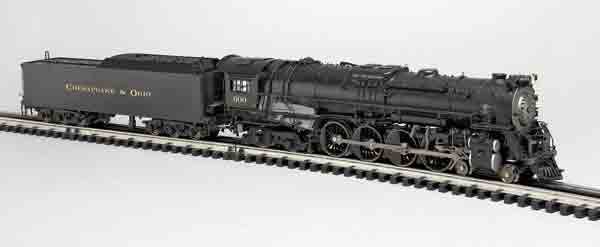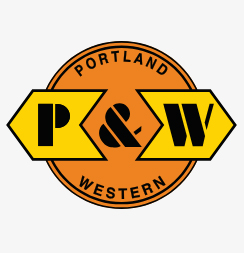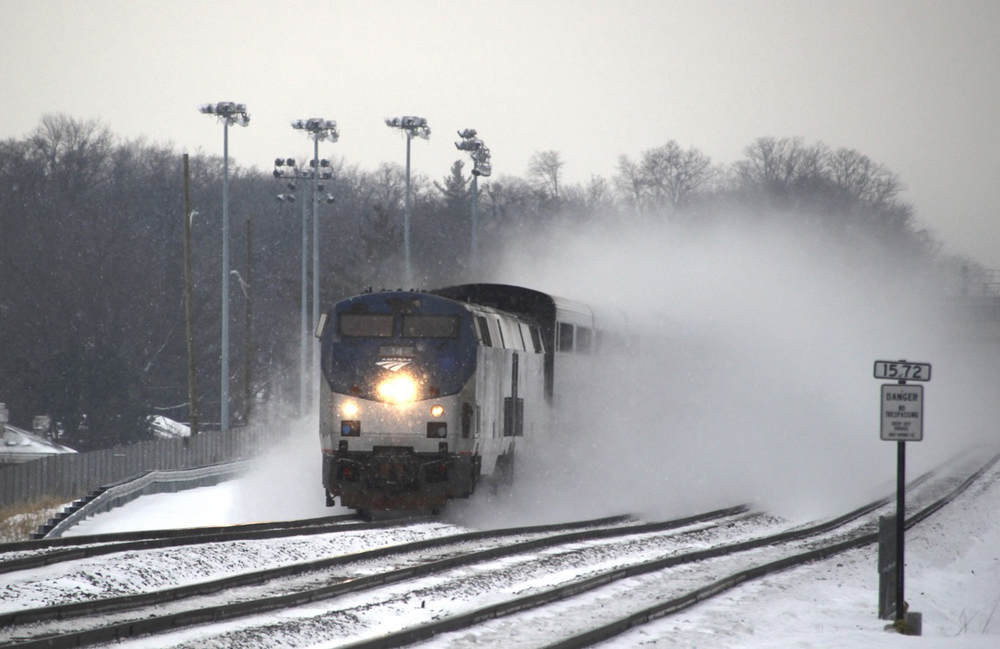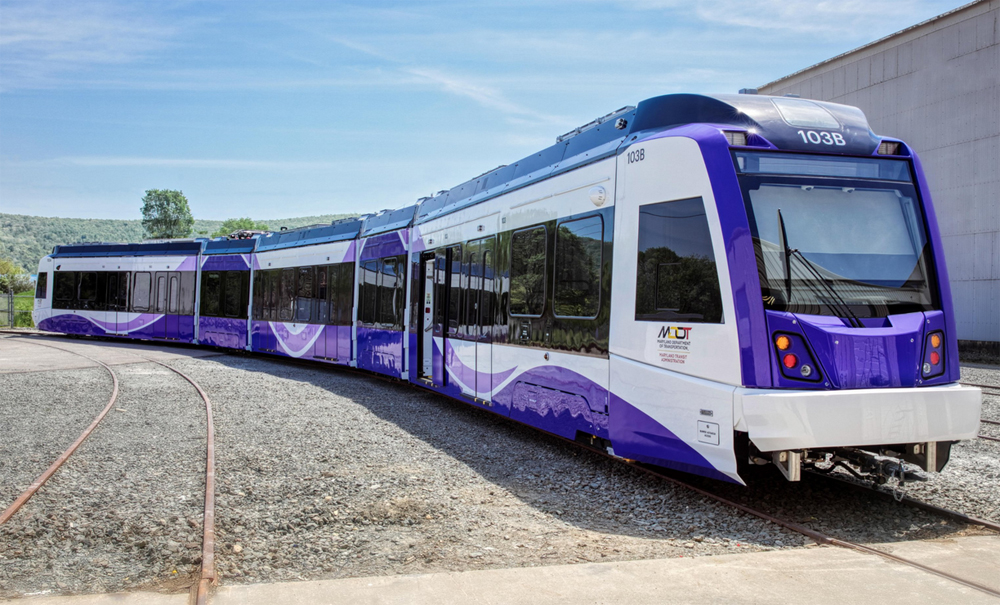The C&O was so pleased, that the line ordered two more in 1941 and five more in 1948 (the J3a class).
Sadly, in spite of their superb performance, these steamers were soon displaced by diesels. The J3s were scrapped by 1953, while the J3a locomotives were shifted to standby service for surges.
The last were retired by 1957.
Out of the box
This O gauge model from 3rd Rail has one of the finest, most industrial-looking faces I have seen on a locomotive. As our prototype photo of C&O no. 600 illustrates, 3rd Rail did an outstanding job capturing the exceptional level of detail on a model that was ripe with pipes, fittings, cables, hoses, and conduit.
The pilot forms a business-like point, and it has a drop coupler recessed in the middle. Two brake lines are forward mounted, and you’ll find an uncoupler arm. I absolutely love low-mounted headlights on steam power.
In my opinion a low-mounted light always suggests serious freight railroading (the only really important aspect of railroading, after all). This O gauge model has a low light with a small service platform just above it and a long grab iron for crewmen servicing the smokebox door.
For the record, historically, the C&O received no. 600 from Lima with the headlight near the center of the smokebox, but later lowered it.
Two compressor shields (and their hidden compressors) bracket the headlight. The smokebox door has superb rivet detail, with both steps and grab irons on the face. Illuminated number boards and markers are placed just above the top of the smokebox, and a bright gold bell is on top.
I love the extensive and intricate combination of handrails, piping, and electrical conduit that decorates the body of the locomotive. The lines have stanchions, joints, or valve handles.
Of special merit is the large sand dome that dominates the top of the boiler. The dome features four lifting hatches (with screens) to “load” sand and piping that feeds sand to the drive wheels. This is truly a case of being able to see where the money goes in the creation of such an exquisite model.
A bit lower on the model, as impressive as the maze of conduit and steam lines is, I find the standout detail of the locomotive in the elaborate running gear – possibly the most complex I’ve ever seen on any O gauge power. The rods and moving parts have a realistic dull sheen and put on a terrific show when the model is under way.
The firebox is silver gray, which accents both the cast-in rivet texture and the piping that passes over it.
The cab features crew figures, an immaculately rigged backhead, illumination, and opening roof vents. The windows have “glass,” and the rear of the cab has grab irons and a drop deck for the tender.
The electronics connect with the locomotive via a wired tether.
The run/program, volume control, and speed-control switches are located on top of the tender beneath lifting water hatches. The smoke unit and selector switches for two- or four-chuff-per-revolution sound are on the underside of the locomotive.
The tender has finely detailed steps and grab irons. The coal load is “chunk” style and looks sharp. Equipment boxes hang low on the sides, and the rear mounts a backup light, ladder, and uncoupler arm.
The trucks all have metal side frames with “Buckeye” emblazoned on them, and they mount three axles. The rear truck has a single power pickup.
Painting and decoration are truly equal to the supreme level of detail encompassed by this model.
The paint and all lettering, such as the “Th. Jefferson” on the sand dome, are clean and crisp. The Lima Locmotive Works builder’s plate is outstanding.
On the test track
This 3rd Rail model features Lionel’s TrainMaster and RailSounds systems as well as a smoke unit and TrainAmerica’s Engineer On Board speed control.
We tested the locomotive using Lionel’s Legacy command system, and performance was first rate.
We thought the Greenbrier just might negotiate O-54 diameter curves. It sort of almost does, but it didn’t seem happy about it. We recommend sticking with O-72 or wider curves.
Our test sample averaged 5.5 scale mph on the low end, and 71 scale mph on the high end. Drawbar pull for the brass giant was 1 pound, 14 ounces.
RailSounds’ steam package delivered a solid sounding group of locomotive sounds, and the two- or four-chuff per rotation control allows operators to tailor the chuff rate to what they “hear” in their imagination.
The locomotive’s whistle is a crowd pleaser! When the whistle starts to blow, you can almost sense it echoing off the West Virginia hills. Two thumbs up, indeed. Smoke unit operation was good, and the speed control was precise and responsive.
When you buy a brass locomotive, you have certain expectations regarding detail, performance, and value. Third Rail has a long record of making well-crafted locomotives. The Greenbrier adds to this reputation with good looks, and it delivers smooth and powerful performance.
Price: $1,1,95.95
Features: O-72 operation, can-style motor, coil coupler, Lionel TrainMaster and RailSound systems, smoke unit, speed control
Staff comments: Supreme level of detail, well-built, good puller – Bob
Made in the Republic of Korea for Third Rail















I had the opporunity to meet and talk to Mort Mann at the York train show a few years ago. Morts 3rd rail models on his table were outstanding in all ways, a feast for train eyes. The latest model is right up to par.I would almost wish that I could become one forty eight size so that I could hitch a ride on that C&O 4-8-4 J class Greenbrier.Just keep rolling them out 3rd rail.
Owning many 3rd Rail models, I find the review on the Chesapeak & Ohio 4-8-4 Greenbriar very much in line with my experiences with their products. Scott Mann and his group produce absoluetly stunning models. I find them very reasonable in cost for what you get. Few other companies produce the models in the detail level that they do for this price range. Another important componet to the Sunset 3rd Rail Model Company is their wonderful customer service that comes with each and every model they produce. I had an issue with an engine several years ago and they took care of it with zero hassles to me. Kudos to a company that supports the industry as they do. Randy Lockett
This is one fantastic engine in looks, and smooth operation. The legacy controller with a momentum setting of 5 makes it start slower and really shows off the engines fine running ability. Only the lionel fef with legacy can run slower.